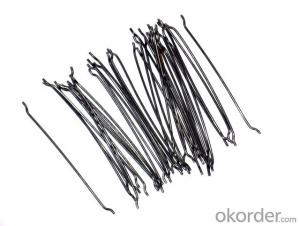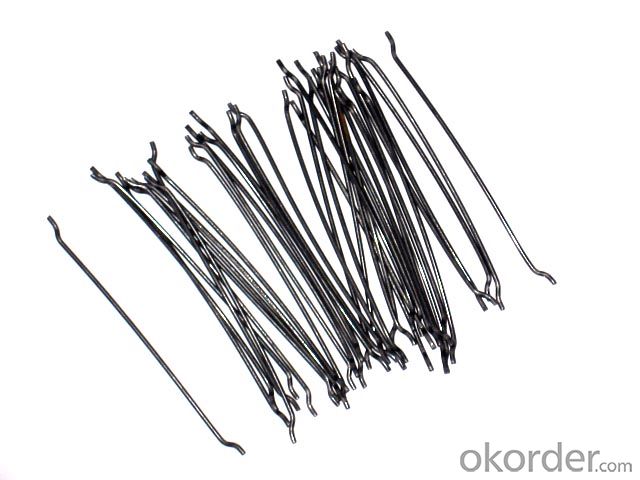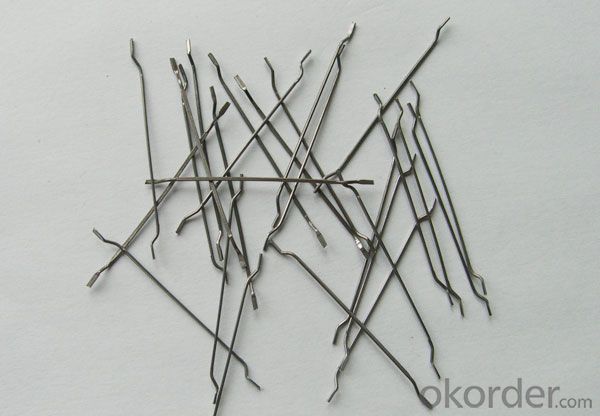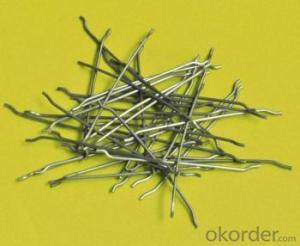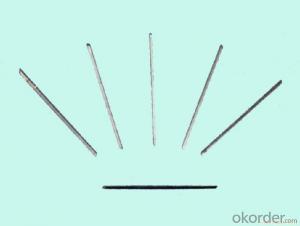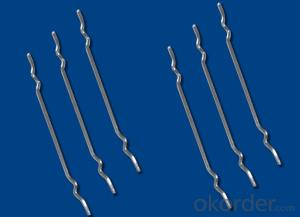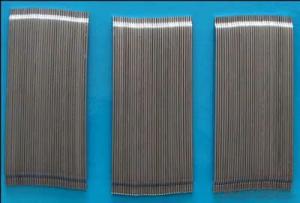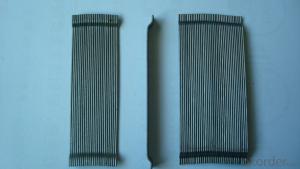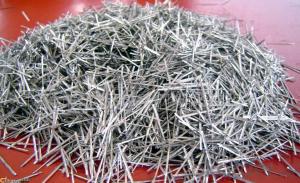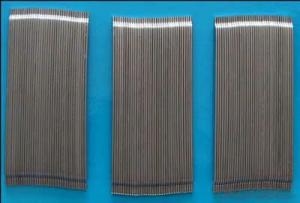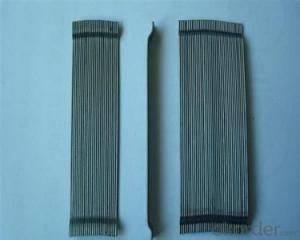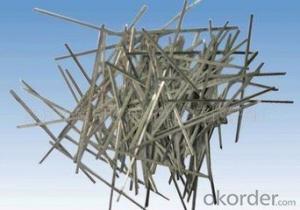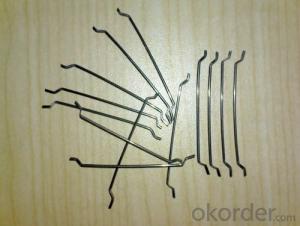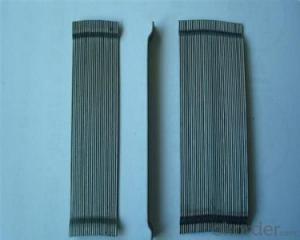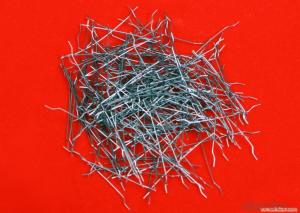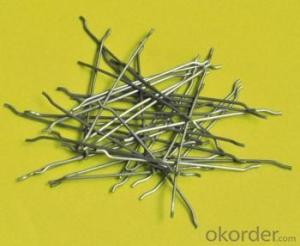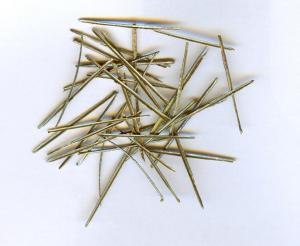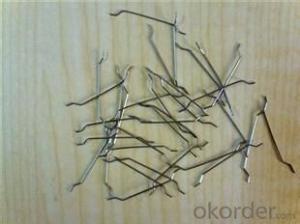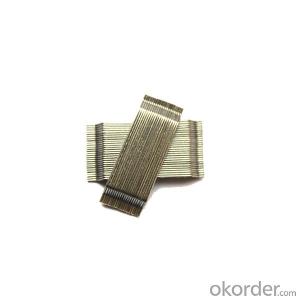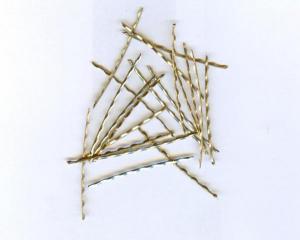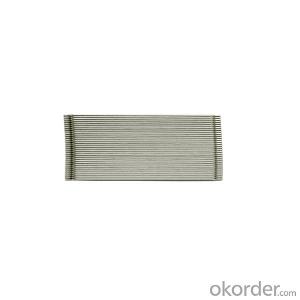Melt Extract Stainless Steel Fiber Loose CNBM International China
- Loading Port:
- Tianjin
- Payment Terms:
- TT OR LC
- Min Order Qty:
- 1000 kg
- Supply Capability:
- 30000 kg/month
OKorder Service Pledge
OKorder Financial Service
You Might Also Like
Quick Details
Place of Origin: Jiangsu, China (Mainland)
Model Number: HT-MC
Material: Color Steel
certificated: ISO 9001
Specifications
The raw material is stainless steel ingots, using electric stoves which melt the stainless steel ingots to become 1500 ~ 1600 ℃ steel liquid, and then with a grooved high speed rotating melt-extracting steel wheel which produces wires that meets are our customers’ specific requirements. When melting down to a wheel steel liquid surface, the liquid steel blow out by slot with centrifugal force at extremely high speed with cooling forming. Melting wheels with water keep the cooling speed. This method is done to produce different material, different sizes of steel fiber.
SIZE | CHEMIC ELEMENT(%) | ||||||
C | P | Mn | Si | Cr | Ni | Al | |
AISI330 | ≤0.40 | ≤0.04 | ≤2.00 | ≤0.75 | 17~20 | 33~37 | |
AISI310 | ≤0.40 | ≤0.04 | ≤2.00 | ≤1.50 | 24~26 | 19~22 | |
AISI316 | ≤0.40 | ≤0.04 | ≤2.00 | ≤1.00 | 16~18 | 10~14 | |
AISI314 | ≤0.40 | ≤0.045 | ≤2.00 | 1.5-3.0 | 23~26 | 19~22 | |
AISI309 | ≤0.40 | ≤0.04 | ≤2.00 | ≤1.00 | 22~24 | 12~15 | |
AISI304 | ≤0.40 | ≤0.04 | ≤2.00 | ≤2.00 | 18~20 | 8~10 | |
AISI301 | ≤0.40 | ≤0.04 | ≤2.00 | ≤2.00 | 16~18 | 6~8 | |
AISI201 | ≤0.40 | ≤0.06 | 5.5~7.5 | ≤1.00 | 16~18 | 3.5~5.5 | |
AISI446 | ≤0.40 | ≤0.04 | ≤1.50 | ≤2.00 | 23~27 | ||
AISI430 | ≤0.40 | ≤0.03 | ≤1.00 | ≤2.00 | 16~18 | ||
NAS430A | ≤0.40 | ≤0.03 | ≤0.50 | ≤0.50 | 16~18 | 2~4 | |
SIZE(mm) | ||||
length | 20 | 25 | 30 | 35 |
width | 0.75~1.5 | 0.75~1.5 | 0.75~1.5 | 0.75~1.5 |
thickness | 0.2~0.75 | 0.2~0.75 | 0.2~0.75 | 0.2~0.75 |
Picture
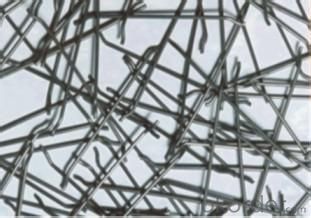
Steel fiber
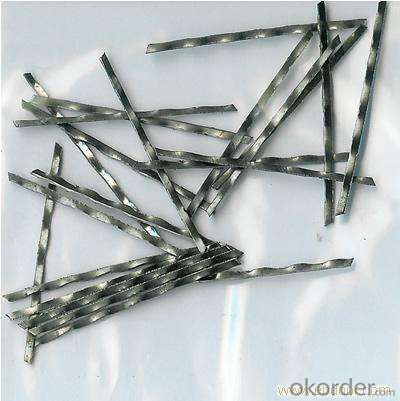
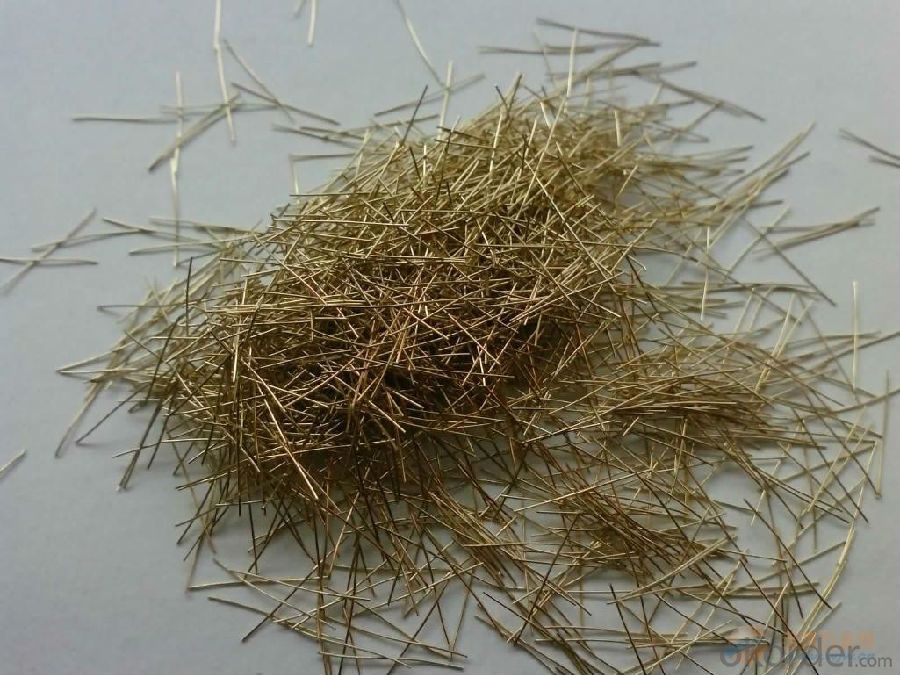
FAQ
1. Metallurgical industry
The refining outside the furnace airbrush, dipping tubes, slag dam, bag lining cover, the triangle electric furnace, furnace cover, the molten iron trench cover, the torpedo cans, coke oven door, the heating furnace of steel rolling door, furnace roof, burn tsui, annular furnace baffle wall, hearth roll, forging steel furnace, steel tanks etc, items can be used for various refractory kiln linings.
2. The construction industry
Steel fiber mixed with mixes clay is rapid development of new composite materials in recent years, especially for the steel fiber concrete fastest development. Steel fiber with excellent tensile, bending, shear and crack resistance, impact resistance, resistance to fatigue, high toughness properties, are all items widely used in construction, road, bridge, tunnel, airport pavement, hydraulic harbor, military engineering, all kinds of buildings and products etc.
3. Kiln
Sintering furnace, reduction furnace, finer, the flue, furnace burning tsui and other heat-resistant linings.
4. Petroleum chemical industry
Especially in the refining the lining of catalytic cracking units.
5. Electric power industry
Thermal power plant boiler heat resistant linings.
6. Environmental protection industry
Incinerator.
- Q: How does melt extract stainless steel fiber enhance the toughness of concrete?
- Melt extract stainless steel fiber enhances the toughness of concrete by improving its resistance to cracking and enhancing its overall durability. The fibers act as reinforcement, distributing the stress throughout the concrete and preventing cracks from forming or spreading. This results in a more resilient and long-lasting concrete structure.
- Q: What is the effect of melt extract stainless steel fiber on the drying time of concrete?
- The effect of melt extract stainless steel fiber on the drying time of concrete is primarily to decrease it. Stainless steel fibers, when added to concrete mixes, enhance the overall strength and durability of the concrete. These fibers act as reinforcement, providing extra tensile strength and crack resistance to the concrete. When it comes to drying time, the addition of melt extract stainless steel fibers can significantly shorten the time it takes for the concrete to dry and cure. This is because the fibers help to control and reduce the amount of shrinkage that occurs during the drying process. Shrinkage is a common issue in concrete, where the material tends to contract as it dries. This shrinkage can lead to cracks and other forms of damage in the concrete. However, the use of stainless steel fibers helps to minimize shrinkage and control cracking, ultimately reducing the drying time. The presence of these fibers also improves the overall performance of the concrete by increasing its resistance to various factors such as temperature changes, chemical attacks, and impact loads. This enhanced durability further contributes to a faster drying time, as the concrete is less susceptible to damage or degradation. In summary, the addition of melt extract stainless steel fiber to concrete can effectively decrease the drying time by controlling shrinkage and enhancing the overall strength and durability of the material. This results in a more efficient and reliable construction process, reducing the time required for the concrete to dry and cure.
- Q: Is melt extract stainless steel fiber compatible with different types of fiber-reinforced polymers?
- Melt extract stainless steel fiber can be combined effectively with various types of fibers, including carbon, glass, aramid, and natural fibers, to enhance the mechanical properties of fiber-reinforced polymers (FRPs). This reinforcement material is commonly used in FRPs to improve their strength, durability, and performance. The excellent adhesion properties and strong bond-forming ability of melt extract stainless steel fiber are the primary reasons for its compatibility with other fibers. This ensures that the steel fibers are uniformly distributed within the FRP, resulting in enhanced load-bearing capacity, crack resistance, and impact resistance. Moreover, the corrosion resistance of stainless steel fibers makes them suitable for use in different environments, even those with high moisture or chemical exposure. This compatibility with various fiber types and environmental conditions allows for the customization of FRPs to meet specific application requirements in industries such as construction, automotive, aerospace, and marine. In conclusion, melt extract stainless steel fiber is compatible with different types of fiber-reinforced polymers, enabling the creation of composite materials with improved mechanical properties and enhanced durability.
- Q: How does melt extract stainless steel fiber improve the resistance to seismic loading in concrete?
- Melt extract stainless steel fiber is a type of reinforcement material that can significantly enhance the resistance to seismic loading in concrete structures. Seismic loading refers to the stress and vibrations experienced by buildings during earthquakes or other seismic events. One of the key mechanisms through which melt extract stainless steel fiber improves seismic resistance in concrete is by enhancing its tensile strength and ductility. Stainless steel fibers are incredibly strong and are capable of withstanding high levels of stress and strain. When added to concrete, these fibers act as a reinforcement, bridging the cracks that occur under seismic loading and preventing them from propagating further. Moreover, melt extract stainless steel fiber also improves the bond between concrete and other construction materials, such as reinforcing bars or steel frames. This increased bond strength helps to distribute the seismic forces more evenly throughout the structure, reducing localized stress concentrations and improving overall stability. Another significant advantage of using melt extract stainless steel fiber in concrete is its ability to absorb and dissipate energy during seismic events. When the ground shakes, the fibers absorb the energy generated by the seismic forces, preventing it from being transferred to the concrete matrix. This energy absorption capability helps to reduce the overall stress on the concrete and enhances its ability to withstand seismic loading. Additionally, melt extract stainless steel fiber can also improve the durability and longevity of concrete structures in seismic regions. The fibers act as a barrier against corrosion and deterioration, preventing the ingress of moisture and harmful chemicals that may weaken the concrete over time. This enhanced durability ensures that the structure remains resilient and can withstand multiple seismic events throughout its lifespan. In summary, melt extract stainless steel fiber improves the resistance to seismic loading in concrete by enhancing its tensile strength, ductility, bond strength, and energy absorption capacity. By mitigating the propagation of cracks, distributing seismic forces more evenly, and increasing the overall durability, this reinforcement material significantly improves the seismic resistance of concrete structures, making them more resilient and safer in earthquake-prone areas.
- Q: Is melt extract stainless steel fiber compatible with various types of cement?
- Yes, melt extract stainless steel fiber is compatible with various types of cement. These fibers are specifically designed to enhance the performance of cement-based materials, including concrete. They provide reinforcement, improve durability, increase crack resistance, and enhance the overall strength of the cementitious matrix. Melt extract stainless steel fibers have excellent chemical resistance, which allows them to maintain their integrity and effectiveness when exposed to different types of cement and other aggressive substances. Therefore, whether it is Portland cement, fly ash cement, or any other type of cement, melt extract stainless steel fibers can be successfully used to enhance its properties and performance.
- Q: What is the effect of melt extract stainless steel fiber on the modulus of elasticity of shotcrete?
- The effect of melt extract stainless steel fiber on the modulus of elasticity of shotcrete is that it increases the overall stiffness and rigidity of the material. The addition of stainless steel fibers to shotcrete helps to improve its mechanical properties, including the modulus of elasticity. Stainless steel fibers are known for their high tensile strength and excellent resistance to corrosion. When these fibers are added to shotcrete, they create a network of reinforcement throughout the material, which enhances its ability to withstand external forces and stresses. The modulus of elasticity is a measure of a material's ability to deform under load and return to its original shape once the load is removed. By incorporating melt extract stainless steel fibers into shotcrete, the overall modulus of elasticity is increased. This means that the shotcrete becomes more resistant to deformation and has a higher stiffness, making it less prone to cracking and improving its overall structural integrity. Additionally, the addition of stainless steel fibers can also help to control and reduce shrinkage cracking in shotcrete. This is particularly important in applications where shotcrete is used as a structural element or as a lining material in tunnels, mines, or other underground constructions. In summary, the effect of melt extract stainless steel fiber on the modulus of elasticity of shotcrete is a significant increase in stiffness and rigidity. This improvement in mechanical properties leads to enhanced durability, reduced cracking, and improved structural performance of shotcrete in various construction applications.
- Q: Does melt extract stainless steel fiber improve the fire resistance of reinforced concrete columns?
- The utilization of melt extract stainless steel fiber effectively enhances the fire resistance of reinforced concrete columns. By incorporating stainless steel fibers into the concrete mixture, the mechanical properties of the concrete, including its fire resistance, are improved. In the event of a fire, the stainless steel fibers serve as reinforcement, safeguarding the concrete against spalling, cracking, or disintegration. As a result, the structural integrity of the reinforced concrete columns is maintained for an extended duration, allowing for increased time for evacuation and firefighting endeavors. Furthermore, the stainless steel fibers also enhance the thermal conductivity of the concrete, enabling the efficient dissipation of heat and impeding the rapid spread of fire. In summary, the inclusion of melt extract stainless steel fiber significantly boosts the fire resistance of reinforced concrete columns, rendering them more dependable and secure in fire-prone settings.
- Q: What is the effect of melt extract stainless steel fiber on the curing time of concrete?
- The inclusion of melt extract stainless steel fiber in concrete can have a significant effect on the curing time of the material. Stainless steel fibers are typically added to concrete mixtures to enhance its mechanical properties, such as its strength, durability, and crack resistance. The presence of stainless steel fibers in concrete affects the curing time primarily by improving the bond between the cement matrix and the aggregate. This enhanced bond increases the rate of hydration, which is the chemical reaction that occurs between the cement and water, resulting in the hardening of concrete. Due to the improved hydration process, concrete containing melt extract stainless steel fibers generally experiences faster initial setting and strength development. This means that the concrete can reach an adequate level of hardness and strength more quickly compared to plain concrete without fibers. As a result, the overall curing time of the concrete is reduced. Additionally, the use of stainless steel fibers can also minimize plastic shrinkage cracking, which occurs during the early stages of concrete curing when the water content evaporates faster than the hydration reaction takes place. By reducing these cracks, the curing time can be further accelerated as there is less need for repair or remediation. However, it is important to note that the specific effect of melt extract stainless steel fiber on curing time can vary depending on various factors, such as the dosage of fibers, aggregate type, environmental conditions, and the overall concrete mixture design. Therefore, it is crucial to conduct thorough testing and analysis to determine the exact impact of stainless steel fibers on the curing time of concrete in a particular application.
- Q: Can melt extract stainless steel fiber be used in concrete bridge decks?
- Yes, melt extract stainless steel fiber can be used in concrete bridge decks. Stainless steel fibers are commonly used as reinforcement in concrete structures, including bridge decks. These fibers improve the overall strength and durability of the concrete, enhancing its resistance to cracking and increasing its load-bearing capacity. Melt extract stainless steel fibers are known for their high tensile strength and corrosion resistance, making them an excellent choice for bridge decks exposed to harsh environmental conditions. Additionally, these fibers can help control shrinkage and prevent the formation of cracks, enhancing the long-term performance and service life of the bridge decks. Overall, melt extract stainless steel fiber is a suitable and beneficial reinforcement option for concrete bridge decks.
- Q: How does melt extract stainless steel fiber affect the curing process of concrete?
- Melt extract stainless steel fiber plays a crucial role in the curing process of concrete, impacting it significantly. When integrated into the concrete mixture, these fibers disperse evenly throughout, offering reinforcement and enhancing the overall strength and durability of the cured concrete. As a reinforcement material, the stainless steel fibers strengthen the concrete's flexural strength, toughness, and resistance to cracking. This reinforcement effect is particularly advantageous in minimizing early-age cracking, plastic shrinkage cracking, and drying shrinkage cracking, which are common during the curing process. Furthermore, the stainless steel fibers improve the bond between the cement paste and aggregates, preventing internal micro-cracking and enhancing the concrete's ability to withstand stresses and loads. This improved bond also lowers the risk of delamination and spalling, thereby increasing the cured concrete's longevity and durability. Additionally, melt extract stainless steel fibers assist in controlling crack formation and propagation in the concrete. By bridging the cracks, these fibers limit their width and restrict their growth, effectively minimizing the potential for structural failure and enhancing the concrete's resistance to external forces. Moreover, the stainless steel fibers aid in managing plastic shrinkage and settlement cracking by reducing the evaporation rate of water from the concrete surface. This slower drying process enables a more controlled and uniform curing, resulting in improved overall strength and reduced permeability of the concrete. In conclusion, incorporating melt extract stainless steel fibers into concrete has a significant impact on the curing process, enhancing the concrete's strength, durability, resistance to cracking, and overall performance. These fibers provide reinforcement, improve bond strength, control crack formation, and reduce shrinkage, ultimately resulting in higher quality and longer-lasting cured concrete.
Send your message to us
Melt Extract Stainless Steel Fiber Loose CNBM International China
- Loading Port:
- Tianjin
- Payment Terms:
- TT OR LC
- Min Order Qty:
- 1000 kg
- Supply Capability:
- 30000 kg/month
OKorder Service Pledge
OKorder Financial Service
Similar products
Hot products
Hot Searches
Related keywords
